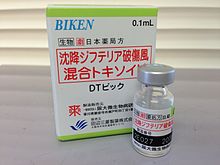
Back Witseerkeelentstof Afrikaans لقاح الخناق Arabic واکسن دیفتری AZB Difterivaccine Danish Diphtherieimpfstoff German Εμβόλιο κατά της διφθερίτιδας Greek Vacuna contra la difteria Spanish واکسن دیفتری Persian Vaccin contre la diphtérie French Allurar rigakafin cutar sankara Hausa
 DT vaccine in Japan | |
| Vaccine description | |
|---|---|
| Target | Corynebacterium diphtheriae |
| Vaccine type | Toxoid |
| Clinical data | |
| MedlinePlus | a607027 |
| Routes of administration | Intramuscular injection |
| ATC code | |
| Legal status | |
| Legal status |
|
| Identifiers | |
| ChemSpider |
|
| | |
Diphtheria vaccine is a toxoid vaccine against diphtheria, an illness caused by Corynebacterium diphtheriae.[2] Its use has resulted in a more than 90% decrease in number of cases globally between 1980 and 2000.[3] The first dose is recommended at six weeks of age with two additional doses four weeks apart, after which it is about 95% effective during childhood.[3] Three further doses are recommended during childhood.[3] It is unclear if further doses later in life are needed.[3]
The diphtheria vaccine is very safe.[3] Significant side effects are rare.[3] Pain may occur at the injection site.[3] A bump may form at the site of injection that lasts a few weeks.[4] The vaccine is safe in both pregnancy and among those who have a poor immune function.[4]
The diphtheria vaccine is delivered in several combinations.[5] Some combinations (Td and DT vaccines) include tetanus vaccine, others (known as DPT vaccine or DTaP vaccine depending on the pertussis antigen used) comes with the tetanus and pertussis vaccines, and still others include additional vaccines such as Hib vaccine, hepatitis B vaccine, or inactivated polio vaccine.[3] The World Health Organization (WHO) has recommended its use since 1974.[3] About 84% of the world population is vaccinated.[6] It is given as an intramuscular injection.[3] The vaccine needs to be kept cold but not frozen.[4]
The diphtheria vaccine was developed in 1923.[7] It is on the World Health Organization's List of Essential Medicines.[8]
- ^ "List of nationally authorised medicinal products - Active substance: diphtheria / tetanus vaccines (adsorbed), diphtheria vaccines (adsorbed)" (PDF). European Medicines Agency. 14 January 2021. Retrieved 28 October 2021.
- ^ Donahue ML, Eberly MD (2022). "Chapter 2: Diphtheria and tetanus". In Jong EC, Stevens DL (eds.). Netter's Infectious Diseases (2nd ed.). Philadelphia: Elsevier. pp. 5–10. ISBN 978-0-323-71159-3.
- ^ a b c d e f g h i j "Diphtheria vaccine: WHO position paper – August 2017" (PDF). Relevé Épidémiologique Hebdomadaire. 92 (31): 417–435. August 2017. hdl:10665/258681. PMID 28776357.
- ^ a b c Atkinson W (May 2012). Diphtheria Epidemiology and Prevention of Vaccine-Preventable Diseases (12th ed.). Public Health Foundation. pp. 215–230. ISBN 9780983263135. Archived from the original on 15 September 2016.
- ^ "Diphtheria Vaccination". Centers for Disease Control and Prevention (CDC). Archived from the original on 2 November 2011. Retrieved 8 November 2011.
- ^ "Diphtheria". World Health Organization (WHO). 3 September 2014. Archived from the original on 2 April 2015. Retrieved 27 March 2015.
- ^ Macera C (2012). Introduction to Epidemiology: Distribution and Determinants of Disease. Nelson Education. p. 251. ISBN 9781285687148. Archived from the original on 5 March 2016.
- ^ World Health Organization (2023). The selection and use of essential medicines 2023: web annex A: World Health Organization model list of essential medicines: 23rd list (2023). Geneva: World Health Organization. hdl:10665/371090. WHO/MHP/HPS/EML/2023.02.